Antinol® Latest Studies
Sorted by recent
 Filter Studies by Smart Tags
Filter Studies by Smart Tags
Bone & JointCardiovascularCase Study & ProceedingCatDogEAB 277™EfficacyExotic PetImmunologyNeuro & BehaviorOphthalmologyOralRabbitRenalRespiratoryRodentSafetySkinUTI
Smart Search
Safety study of polyunsaturated fatty acids extracted from New Zealand green lipped mussel and krill on hematology and blood chemistry profiles of healthy

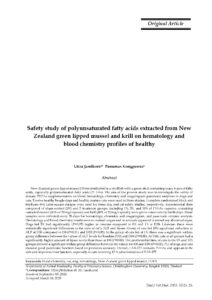
Abstract
New Zealand green-lipped mussel (Perna canaliculus) is a shellfish with a green shell containing many types of fatty acids, especially polyunsaturated fatty acids (PUFAs).
The aim of the present study was to investigate the safety of dietary PUFAs supplementation on blood hematology, chemistry and coagulogram pancreatic enzymes in dogs and cats. Twelve healthy beagle dogs and healthy mature cats were used in these studies. Complete randomized block and triplicate 4×4 Latin square designs were used for these dog and cat safety studies, respectively. Experimental diets composed of sham control (0X) and 3 treatment groups, including 1X, 3X, and 10X of PUFAs capsules containing extracted mussel (60% or 30 mg/capsule) and krill (40% or 20 mg/capsule), were given consecutively for 56 days.
Blood samples were collected every 28 days for hematology, chemistry and coagulogram, and pancreatic enzyme analysis. Hematology and blood chemistry results were in normal ranges and no animals appeared to reveal any abnormal signs.
Dogs fed 3X had significantly (P<0.05) higher in creatine compared to 0X and 1X at D28. Likewise, there were statistically significant differences in the time of cat’s ALT and lipase. Group of cats fed 10X significant reduction in ALT at D56 compared to D0 (P<0.01) and D28 (P<0.05).
In the group of cats fed at 1X, there was a significant within-group difference between the values of ALT levels for baseline (D0) and D56 (P<0.05). At D56, cats in all groups had a significantly higher amount of lipase levels than those at D0 (P<0.05). The prothrombin time of cats in the 0X and 10X groups showed a significant within-group difference between the values for D0 and D56 (P<0.05). PLI of dogs and cats showed good pancreatic function based on precision accuracy.
Overall, EAB-277 contains PUFAs and appears to be safe and improves liver function, especially in cats receiving 10 X administration of EAB-277.
Keywords: blood chemistry, cat, dog, hematology, New Zealand green lipped mussel, PUFA

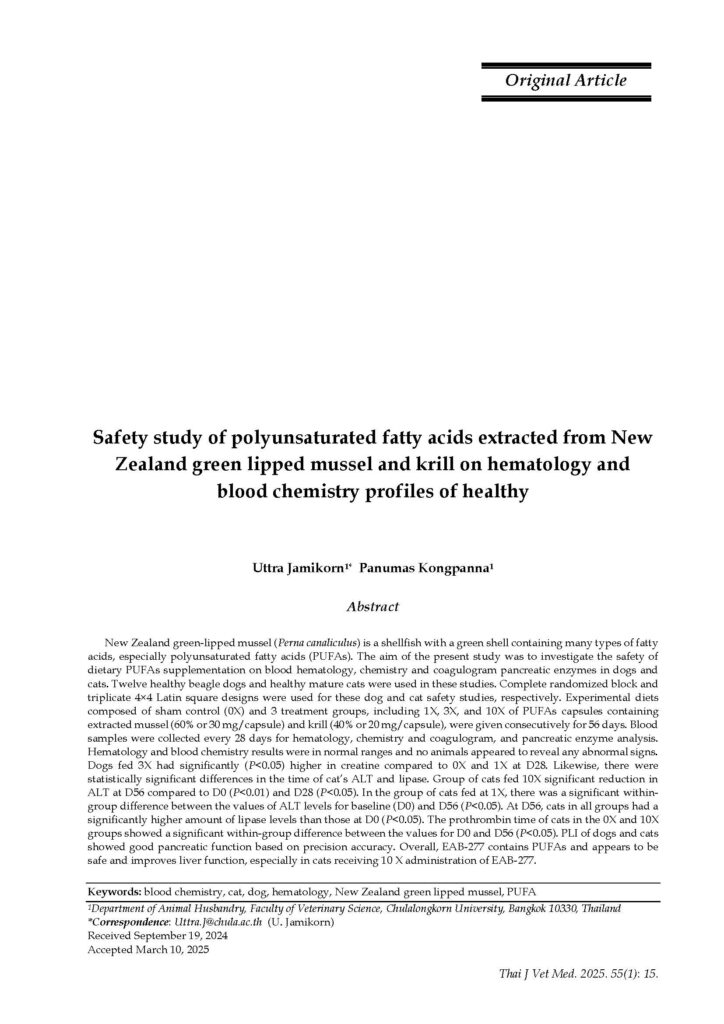
Antinol® Case Study Contest 2022


Evaluation of the comparative efficacy of green lipped mussel plus krill oil extracts (EAB-277), Biota orientalis extracts or NSAIDs for the treatment of dogs with osteoarthritis associated pain: a blinded, placebo-controlled study

With little to no regulation of the supplement markets and a paucity of quality information regarding clinical utility of individual marketed supplements, it is difficult for veterinarians to provide any evidence-based recommendations to owners. The current study aimed to provide clinically useful comparative efficacy data on certain marketed supplements.
Discussion: Results of this study indicate that meloxicam and EAB-277 have significant objectively measured benefits in managing OA-related pain in dogs compared to placebo, but 4CYTE does not differ from placebo.
Antinol® EAB-277® – The Executive Summary

Antinol® Rapid is a potent synergistic blend of 2 marine lipid extracts chosen for their unique enhancement formula called EAB-277®.
EAB-277® is the key active ingredient of this advanced formula formulated to promote optimal benefits through its synergistic efficacy contains > 90 free fatty acids full spectrum of Omega 3 including ETA, EPA, DHA as well as other key Polyunsaturated fatty acids (PUFAs) and antioxidants.
The two marine lipids used in Antinol® Rapid are proprietary and exclusively produced. The exact combination of 30mg lipid fractions from Perna canaliculus (New Zealand green lipped mussel) and 20mg high phospholipid krill oil is the result of years of research combining and isolating lipid groups and essential fatty acids to find the optimal nutrient synergy.
EAB-277®’s proprietary high phospholipid krill oil is high in polar lipid enrichment which enhances bioactivity “Potency” of this marine oil blend formula as a result of proven efficacy.
The Antinol® Rapid EAB-277® blend has been proven via laboratory tests to be more effective than either of the individual lipids alone in inhibiting inflammation markers such as nitric oxide, TNFα, and IL-6.



A randomised, double-blinded, controlled trial to determine the efficacy of combined therapy of oclacitinib and marine oil extract PCSO-524 in dogs with atopic dermatitis

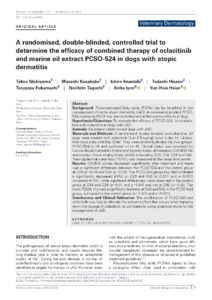
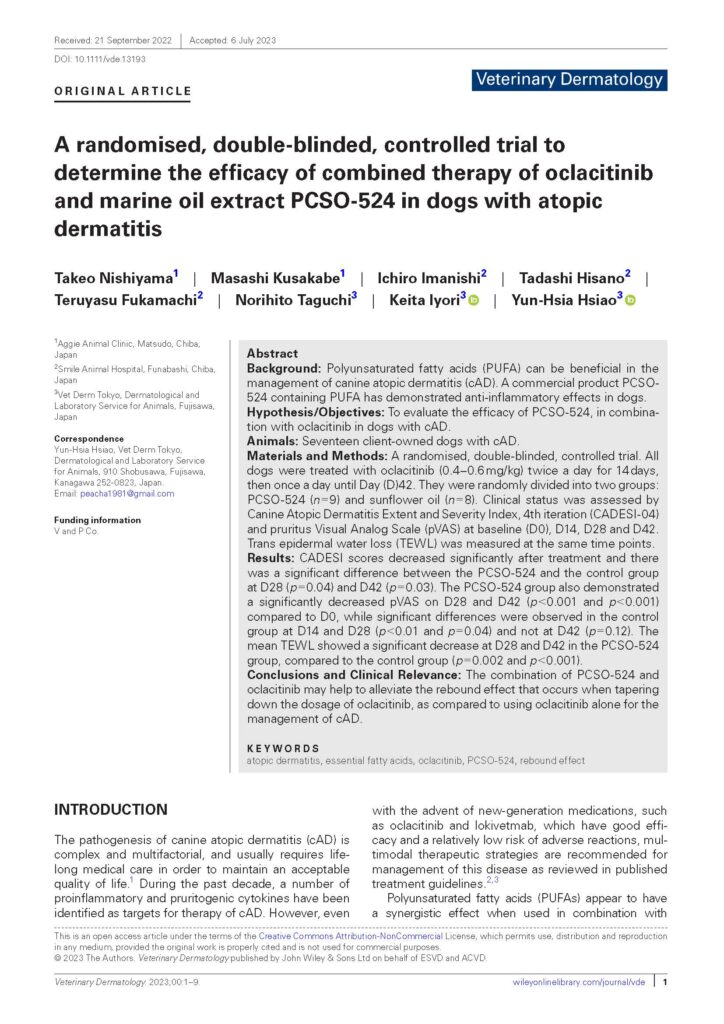
Preliminary Study on Treatment Outcomes and Prednisolone Tapering after Marine Lipid Extract EAB-277 Supplementation in Dogs with Immune-Mediated Hemolytic Anemia


Simple Summary: Immune-mediated hemolytic anemia (IMHA) in dogs is a common autoimmune disease which is accompanied with a high death rate and therapeutic challenges. A natural antiinflammatory nutraceutical product, EAB-277, is derived from marine lipids. Unfortunately, the effects of EAB-277 in IMHA dogs has rarely been investigated. The objective of this study is to assess the clinical effects of EAB-277 and prednisolone dose-tapering for supplemental therapy in IMHA dogs. The findings provide evidence that standard therapy combined with EAB-277 can improve hematological and blood chemistry profiles, resulting in a higher survival rate in IMHA dogs. Furthermore, EAB-277 supplementation can reduce prednisolone dosage tapering and improve the quality of life of IMHA dogs. However, a longer-term study with a larger sample size is necessary to corroborate these findings. As a result, marine EAB-277 is a promising alternative to existing medication for IMHA. Since the nutraceuticals have been utilized not only for nutrition but also as supplemental therapy for the treatment of a wide range of illnesses, such as minimizing the adverse effects of immunosuppressive therapy with steroids.
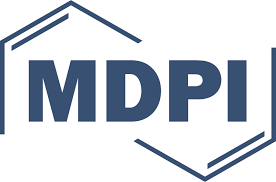

Study of the effectiveness of glucosamine and chondroitin sulfate, marine based fatty acid compounds (PCSO-524 and EAB-277), and carprofen for the treatment of dogs with hip osteoarthritis: A prospective, block-randomized, double-blinded, placebo-controlled clinical trial


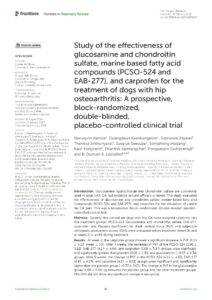
Canine tracheal collapse is a progressive disease in small breed dogs resulting from chronic inflammation of the tracheal mucosal lining. Polyunsaturated fatty acid EAB-277® is one of the nutraceuticals that can alleviate inflammation and oxidative stress. Heart rate variability (HRV) is a prognostic tool related to sympathovagal balance and oxidative stress level, which is widely used with cardiorespiratory diseases. However, the effect of EAB-277® on HRV in tracheal collapse dogs has rarely been investigated.
Introduction: Glucosamine hydrochloride and chondroitin sulfate are commonly used in dogs with OA, but evidence around efficacy is mixed. This study evaluated the effectiveness of glucosamine and chondroitin sulfate, marine based fatty acid compounds (PCSO-524 and EAB-277), and carprofen for the alleviation of canine hip OA pain. This was a prospective, block-randomized, double-blinded, placebo-controlled clinical trial.
Methods: Seventy-five owned pet dogs with hip OA were assigned randomly into five treatment groups: PCSO-524, Glucosamine and chondroitin sulfate, EAB-277, carprofen, and Placebo (sunflower oil). Peak vertical force (PVF) and subjective orthopedic assessment scores (OAS) were evaluated before treatment (week 0), and at weeks 2, 4, and 6 during treatment.
Results: At week 2, the carprofen group showed a significant increase in PVF (3.14 ± 5.33; mean ± SD). After 4 weeks, the increases in PVF of the PCSO-524 (3.90 ± 3.52), EAB-277 (4.17 ± 4.94), and carprofen (3.08 ± 5.87) groups were significant, and significantly greater than placebo (0.08 ± 1.90) and glucosamine (−0.05 ± 6.34) groups. After 6 weeks, the change of PVF in the PCSO-524 (4.14 ± 4.65), EAB-277 (4.45 ± 4.23), and carprofen (4.21 ± 6.52) groups were significant and significantly higher than the placebo group (−0.33 ± 3.65). The change in PVF in the glucosamine group (1.08 ± 5.49) lay between the placebo group and the other treatment groups. The OAS did not show any significant change in any group.
Discussion: PCSO-524 and EAB-277, but not glucosamine/chondroitin, resulted in significant improvements in PVF from baseline after 4 weeks, and 6 weeks, and to a similar degree to that seen with carprofen.

Polyunsaturated Fatty Acid EAB-277® Supplementation Improved Heart Rate Variability and Clinical Signs in Tracheal Collapse Dogs


Canine tracheal collapse is a progressive disease in small breed dogs resulting from chronic inflammation of the tracheal mucosal lining. Polyunsaturated fatty acid EAB-277® is one of the nutraceuticals that can alleviate inflammation and oxidative stress. Heart rate variability (HRV) is a prognostic tool related to sympathovagal balance and oxidative stress level, which is widely used with cardiorespiratory diseases. However, the effect of EAB-277® on HRV in tracheal collapse dogs has rarely been investigated.
In this study, 26 tracheal collapse dogs were divided into two groups. In the control group, the dogs received the standard treatment, whereas the dogs in the EAB-277® group received standard treatment combined with EAB-277®. After being treated for 5 weeks, changes in radiographic findings, blood profiles, serum malondialdehyde, inflammatory markers, and HRV were evaluated. This study found that clinical signs were improved in both groups (p < 0.05). However, serum malondialdehyde (MDA), Interleukin-6 (IL-6), and Tumor necrosis factor-alpha (TNF-α) were decreased only in the EAB-277® group after treatment for five weeks (p < 0.05) and the mean percent change of MDA, IL-6, and TNF-α at week five compared to baseline in the EAB-277® group was greater than in the control group (p < 0.05).
Additionally, greater sympathovagal imbalance indicated by decreased standard deviation of all normal R-R intervals (SDNN) and standard deviation of the averaged R-R intervals for all 5-minutes segments (SDANN) was found in the control group at week five compared to baseline (P < 0.05), whereas EAB-277® improved SDNN and SDANN and decreased low frequency/high-frequency component (LF/HF ratio) after being treated for five weeks (P < 0.05). This study demonstrates that EAB-277® improves clinical signs and attenuates HRV impairment by reducing oxidative stress and inflammation in tracheal collapse dogs.

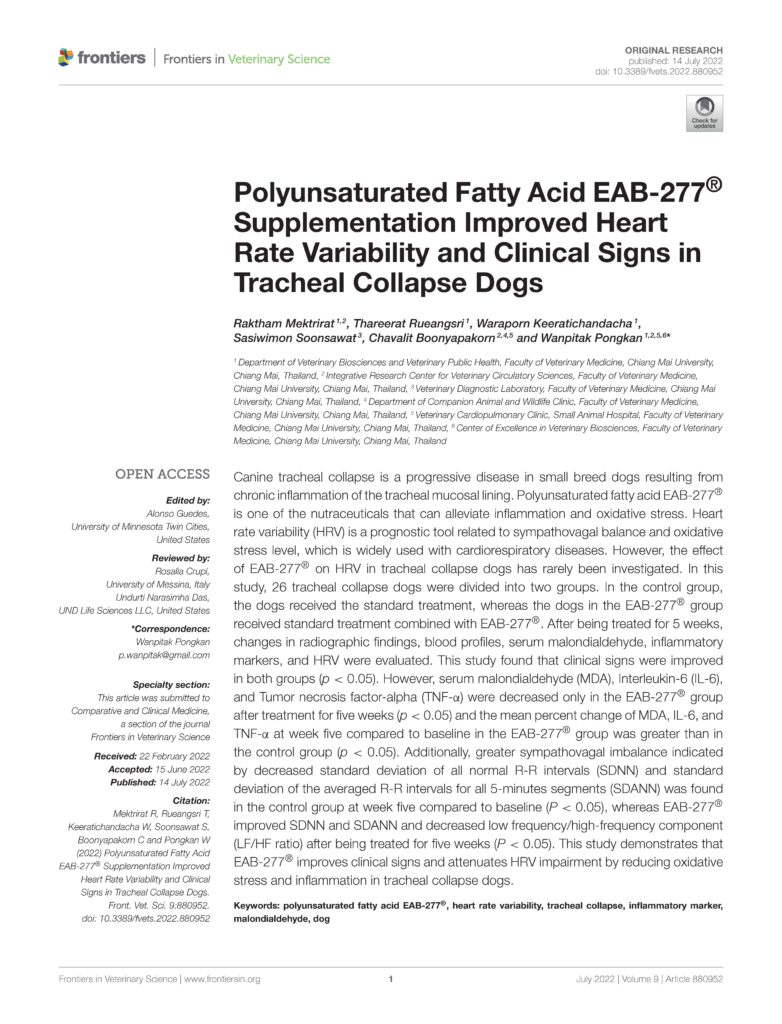
The Effectiveness of Marine Based Fatty Acid Compound (PCSO-524) and Firocoxib in the Treatment of Canine Osteoarthritis

This randomized double blinded study included 79 mixed breed dogs that had hip and/or stifle OA with X-ray confirmation. Outcome measures were changes in Kinetic force plate gait analysis-Peak Vertical Force (PVF), the Orthopedic Assessment Score (OAS), Canine Brief Pain Inventory score (CBPI), and serum prostaglandin E2 concentration (PGE2).
The results of the study suggest that within each group of a combination (PCSO-524 and Firocoxib), PCSO-524, Firocoxib showed the significant improvement of weight bearing ability but not in the comparison between.
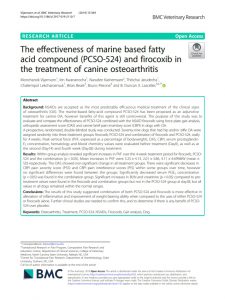
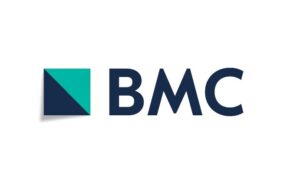
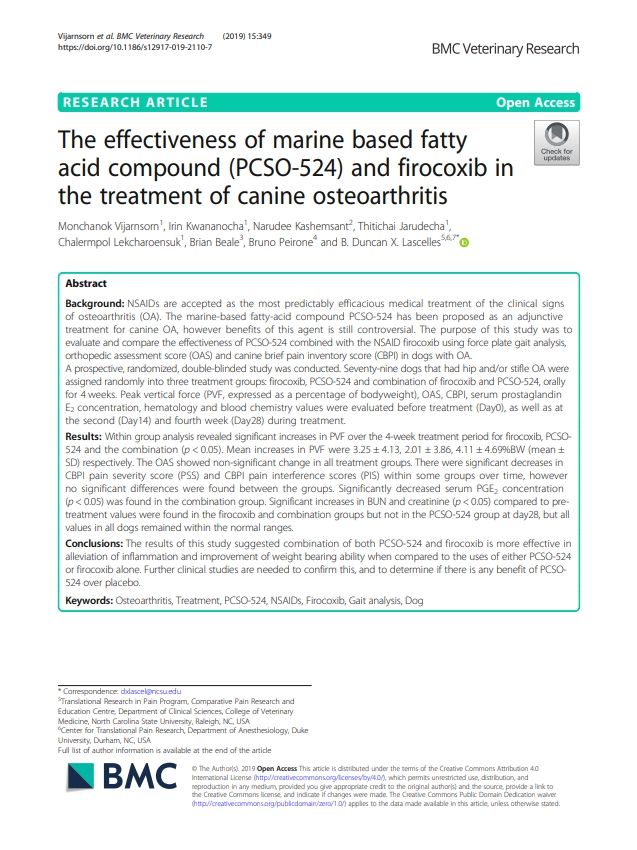
The Effectiveness of Marine Based Fatty Acid Compound (PCSO-524) Alone and Combined with Firocoxib in the Treatment of Canine Osteoarthritis

(VOS conference, March 2018)
This randomized study involved 31 mixed breed dogs with x ray confirmed OA of stifle joint. They were split into 2 groups for four weeks of treatment.
The results showed a non-significant effect of the treatment on the adjusted Peak Vertical Force (PVF) value (p=0.447) among the 2 treatment groups.
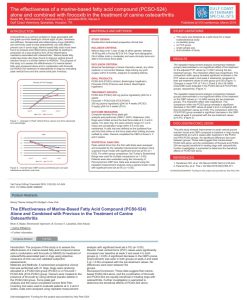
![]()
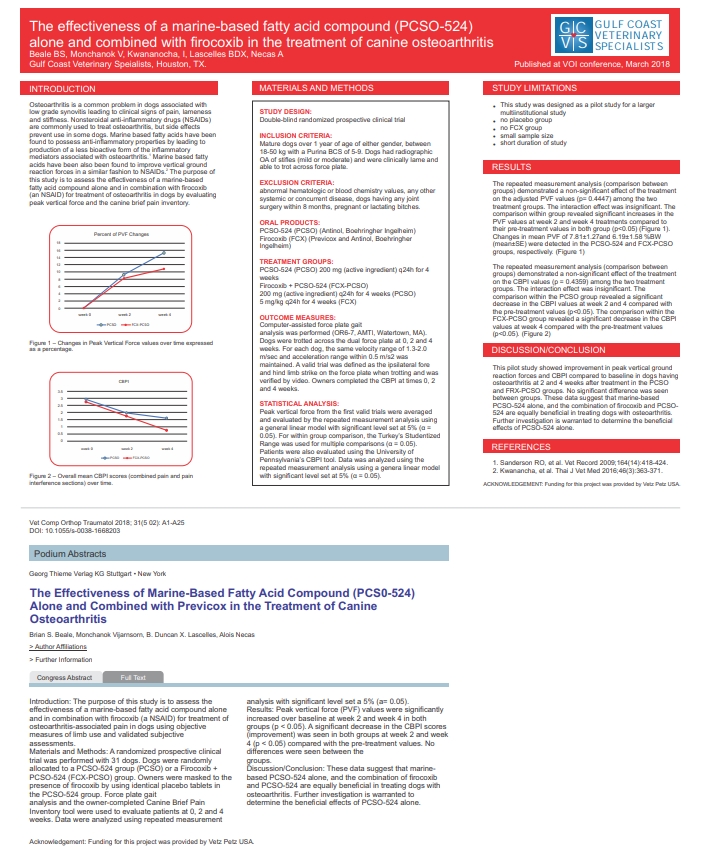

Updated Study Topics
New researches and publications related to PCSO-524® and its result in clnical test submitted by veterinarians on the global conferences every year and the data keeps growing with more studies conducted


 Authors:
Authors: